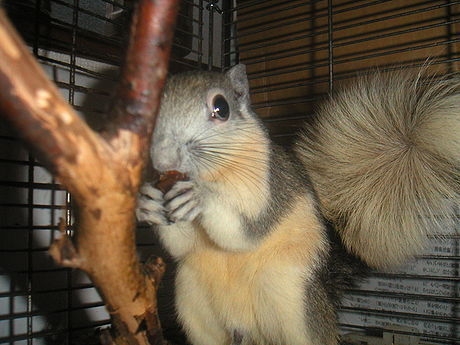
Fynlayason's squirrel(Callosciurus finlaysonii)
Phylum —chordata
Class — mammalia
Order — rodentia
Family — sciuridae
Genus – callosciurus
Appearance
Coat color in Finlayson's squirrels varies according to subspecies and members within subspecies. The coat color may range from all white, to all red, to all black. Due to the variability of the coat color of this species, it is often referred to as variable squirrel.
On average, the head to body length of females is 191.8 mm. The average tail length in females is 172.8 mm. For males, the average head to body length is 190.1 mm, and average tail length is 173.4 mm. The average mass of adults (in both sexes) is 278.0 g.
Habitat
It is found in Cambodia, Laos, Myanmar, Thailand, and Vietnam.
Behavior
Finlayson's squirrels spend from 75.9% to 96.3% of their time active, with a major proportion of that time spent foraging.
There have been 10 types of vocalizations identified in this species, in particular in the members that reside in Acqui Terme. They consist of alarm signals in the presence of cats and of magpies, male distant calling signals, male close calling signals, male courtship calls (made of three sequences of emissions with different intervals), mating calls, mother distant calls, young distant calls, and squeaks. It is likely that they also communicate with visual and chemical cues.
Diet
Finlayson's squirrels spend a majority of their active time foraging. Their diet varies seasonally and regionally. For example, they will feed on bark and buds during the winter, flowers in the spring, and then mature seeds and fruit between June and October. In the summer, the squirrels will search for and eat insects.
Reproduction
As a member of the family Sciuridae these squirrels have a polygyandrous mating system in which many males can mate with many females. Males will perform mating calls and mating chases as a part of mating rituals. Finlayson's squirrels have three reproductive periods: April, July to August, and November to December.
Females have only 1 to 2 offspring during each one of these reproduction periods, and females reach sexual maturity at about their 2nd year of life. Finlayson's squirrels have a high reproductive rate because sexual maturity is reached early and the females have a short gestational period. Finlayson's squirrels build nests from plant material to care for their young. Females care for the young.
Incaptivity
Limited information is available for the lifespan of Finlayson's squirrels. In captivity, they are known to survive a maximum of 12.8 years.
To keep Finlayson's squirrel, you need a small aviary or a spacious cage where the squirrel can move freely. A spacious aviary and other favorable conditions for keeping squirrels - a guarantee that they will willingly reproduce in captivity and bring quite viable offspring.
It should be remembered that, like all rodents, Finlayson's squirrels have teeth that grow during the whole their lives, and the cage must have branches not only for climbing, but also for grinding teeth. Pieces of thick branches of apple trees or other fruit trees are best suited for this purpose.
In feeding, these animals are unpretentious, which in no case means monotonous feeding. On the contrary, you should use a variety of feeds: all kinds of nuts, sunflowers, various grains, a variety of fruits, yoghurts, cottage cheese, boiled, and sometimes raw quail eggs. In nature, squirrels often eat сhicks, so sometimes their diet can be varied and a piece of cooked lean beef or a chicken can be added.
 Russian
Russian
 English
English























